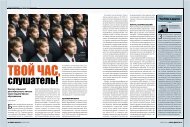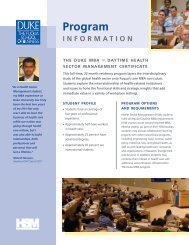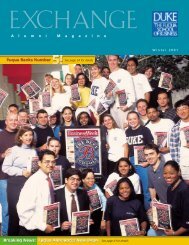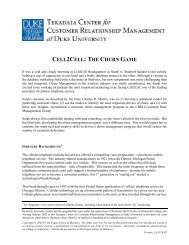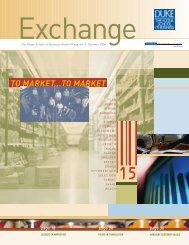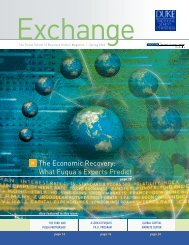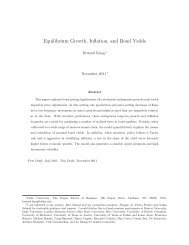Douglas T. Breeden - Duke University's Fuqua School of Business
Douglas T. Breeden - Duke University's Fuqua School of Business
Douglas T. Breeden - Duke University's Fuqua School of Business
You also want an ePaper? Increase the reach of your titles
YUMPU automatically turns print PDFs into web optimized ePapers that Google loves.
The Shah was extremely pleased with this ingenious<br />
game and granted the Grand Vizier a wish for any reasonable<br />
gift he so pleases. The Grand Vizier named his<br />
price, and he wished to have one single grain <strong>of</strong> rice on the<br />
first square, two grains on the second, four grains on the<br />
third square, eight grains on the fourth, doubling in number<br />
<strong>of</strong> grains as he moved to the next square until he reached<br />
all <strong>of</strong> the sixty-four squares. The Shah responded that the<br />
Grand Vizier was too humble in his request and that he<br />
should at least request a mansion, a castle, or something<br />
befitting this ingenious contraption. The Grand Vizier<br />
stuck to his request.<br />
So let’s work out the mathematics <strong>of</strong> the number <strong>of</strong> rice<br />
grains. If you have the patience to continue doubling the<br />
number <strong>of</strong> rice grains per the algorithm above, then you<br />
will come to 9.2 million trillion grains <strong>of</strong> rice. That is 9.2<br />
followed by 18 zeros. We don’t know how the Shah and the<br />
Grand Vizier settled this contract, but I want to point out<br />
that this “doubling effect” can quite quickly catch up and<br />
even overtake your imagination.<br />
BACTERIA POLITICS<br />
Picture a bottle <strong>of</strong> coke full <strong>of</strong> this black sugared water.<br />
Bacteria eats the sugared water as food and breeds by<br />
doubling every minute. It takes 60 minutes for the<br />
bacteria to finish the coke and fill the whole bottle with<br />
bacteria. So the question is: at which minute is the bottle<br />
half-full? The obvious answer is “at the 59th minute.”<br />
Now imagine at the 59th minute some bacterium environmentalist<br />
raises the alarming issue <strong>of</strong> this bacteria<br />
coke bottle world running out <strong>of</strong> foods and space. The<br />
prime minister <strong>of</strong> this bacteria population standing on<br />
top <strong>of</strong> the pile <strong>of</strong> bacteria at the half-way point in the bottle<br />
then downplays this by pointing out that there is as much<br />
space available as there is bacteria. And one minute later,<br />
lights out for every bacteria. This doubling effect is lethal.<br />
It just happens that bacteria doubles its population every<br />
one minute while the human population doubles every<br />
fifty-three years.<br />
FINITY AND SCARCITY<br />
One <strong>of</strong> the key tenets behind economics is scarcity. More<br />
<strong>of</strong> something means less <strong>of</strong> something else. More people,<br />
less cows. More cows, less grass. More guns, less butter,<br />
or more health care, less roads and so on.<br />
Living matters consist in large parts <strong>of</strong> carbon and<br />
hydrogen molecules. Plant and vegetables are carbonbased.<br />
Humans eat these vegetables and inhale oxygen,<br />
expend energy, and exhale carbon dioxide. The energy<br />
that is not expended is stored as fat. Animals do the same.<br />
Should humans leave those animals and plants to die by<br />
themselves, they get trapped under the ground for a<br />
couple <strong>of</strong> million years only to become hydrocarbons—<br />
fossil fuels such as oil, gas, coal. Starch, fat, and oil are<br />
just stored energy and all provide colorific values. So,<br />
these molecules dance around changing pairs back and<br />
forth, but they really never disappear—exchanging,<br />
releasing, and storing differing forms <strong>of</strong> energy.<br />
About thirty years ago, I found myself in remote southern<br />
Thailand, and that was my first time seeing a village<br />
petrol station. Unless somebody told me, I wouldn’t have<br />
recognized that it was a petrol station. On the “pump” side<br />
<strong>of</strong> the business, lay an array <strong>of</strong> old whiskey bottles filled<br />
with sunset-orange liquid, gasoline, on a wooden table<br />
just <strong>of</strong>f a dusty road.<br />
Villagers visit on motorcycles and get refills from these<br />
bottles. And when it was time to pay for the gasoline,<br />
some paid with cash and many others paid with eggs and<br />
the next person paid with vegetables and another with<br />
fruits. Something dawned on me: the most common<br />
denominator next to money in today's society is probably<br />
oil (if you’re sentimental about symbols <strong>of</strong> immortality,<br />
then go ahead and choose gold). Just about everything in our<br />
lives that we are exposed to, either directly or indirectly,<br />
consumes oil. It is no wonder that this base effect has<br />
had on just about the price <strong>of</strong> every commodity. So, this<br />
Malthusian effect has a broader application.<br />
One way <strong>of</strong> looking at this is to trace the history <strong>of</strong> oil,<br />
and you will find that we have only become addicted to oil a<br />
little over a hundred years ago. The first well, the Drake<br />
well, was drilled on August 29, 1859.<br />
In fact, long before the Drake well, oil had been oozing<br />
out <strong>of</strong> subterranean springs in Ohio onto the Oil Creek.<br />
However, there was no significant volume for oil application—oil<br />
addiction—until around 1900: the British<br />
Navy converted their coal-fired battleships to oil in<br />
1902, and Ford’s Model T rolled out in 1908. At the same<br />
time, we should not belittle oil up to that point because<br />
it has done well enough to have enriched John D.<br />
Rockefeller amongst others.<br />
Oil prices have been low and flat up until 1973. In nominal<br />
price, oil is 19.56 times higher today than it was in<br />
1973. In 2005 money, the oil price is 4.43 times higher<br />
than it was in 1973. This is a thirty-four year period. If you<br />
think in terms <strong>of</strong> a fifty-three year period <strong>of</strong> doubling<br />
world population and increasingly we have become an<br />
oil-dependent population, the Malthusian effect and The<br />
Hubbard’s Peak are both showing an emphatic trend.<br />
summer 2007 31





